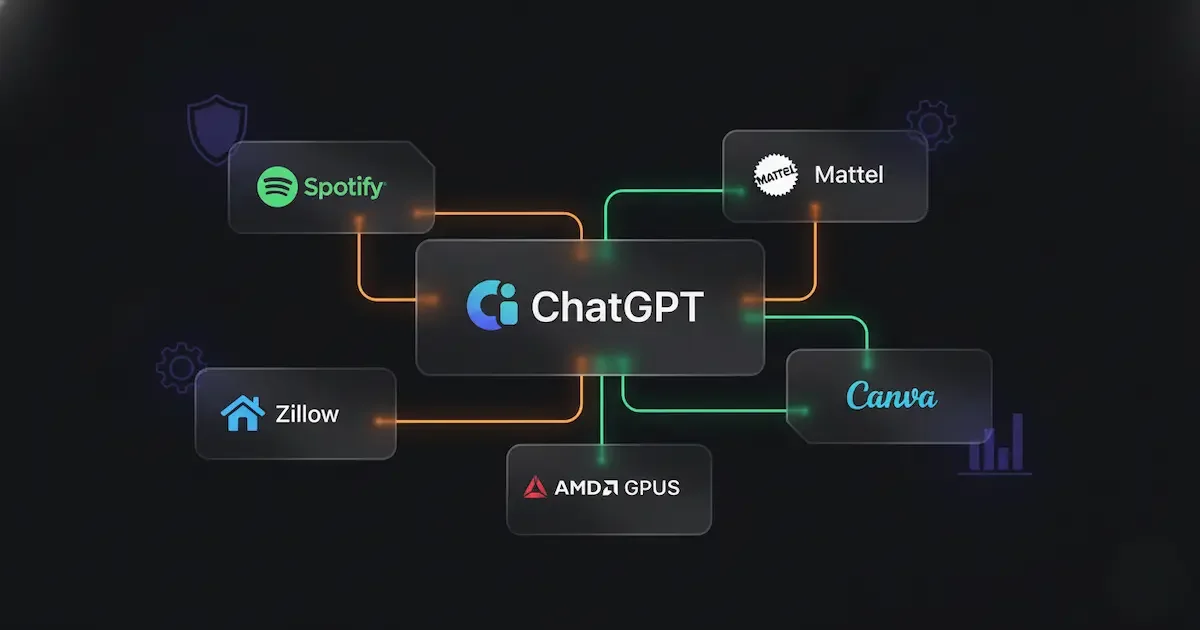OpenAI’s new playbook: make ChatGPT your app hub
OpenAI is turning ChatGPT into a place where work actually happens, not just where you brainstorm. The company launched “apps in ChatGPT” and a developer SDK so third-party services can function inside the chat window. In demos, users asked Canva to draft a poster and then a pitch deck without leaving ChatGPT; Zillow surfaced homes on an interactive map; Spotify was shown as an integration partner; more partners like Booking, Coursera, Expedia, and Figma are in the first wave, with DoorDash, OpenTable, Target, and Uber queued up.
OpenAI also said these apps will come to ChatGPT Business, Enterprise, and Edu later this year, plus a directory where companies can discover and deploy them—basically, an enterprise app store with chat as the front end.
The quote that matters—and why it matters
Reuters captured the strategic posture in one line: OpenAI declared a “huge focus” on enterprise growth and highlighted partnerships with Spotify, Zillow, and Mattel. For context, OpenAI leadership framed ChatGPT as something close to an operating system for interactive apps, with a stack aimed at helping developers build more reliable, task-oriented agents. Translation: fewer copy-paste rituals, more automated workflows that actually complete tasks.
Hardware muscle: keeping the lights on for all that AI
Behind the software announcements is a bigger, louder signal—compute. OpenAI and AMD announced a multi-year deal to deploy 6 gigawatts worth of AMD Instinct GPUs (starting with 1 GW in 2026), which diversifies OpenAI beyond Nvidia and secures a path to keep enterprise-grade features performant. If you’ve been burned by model latency and flaky throughput in pilots, this matters.
What this means for Indian companies (and why you should care today)
1) Chat as the new integration layer. Your users—and your employees—live in chat. If your product or internal tool isn’t available as a ChatGPT app, expect drop-off. Building a lightweight app via the new SDK could become table stakes for SaaS companies and IT services firms in India that sell abroad.
2) Faster POCs and shorter RFP cycles. With apps inside ChatGPT and an upcoming directory for discovery, procurement teams can try your integration the same day. Yes, that compresses sales cycles—but it also raises the bar on quality. Expect security reviews and admin controls to matter more than glossy demos.
3) Real workflows, not just chat summaries. Zillow showing live maps, Canva spinning out assets, Spotify curating—these are concrete tasks. For Indian BFSI, retail, and logistics, a similar pattern means: fetch customer context, trigger back-office actions, and return confirmations in the same thread. If your process needs an “open the other app and paste this” step, consider it technical debt.
4) Infra budgets will feel it. The AMD deal signals OpenAI wants capacity for serious enterprise loads. If you’re building on their stack (or competing with it), plan for cost curves that fluctuate with GPU availability—but also for improved reliability as that capacity comes online.
5) Governance will separate pilots from production. Nothing kills an AI rollout faster than compliance surprises. Start your governance playbook now: data residency (esp. if customer data stays in India), role-based access, prompt logging, and human-in-the-loop checkpoints for high-risk actions. (OpenAI’s enterprise tiers and submission standards for apps are explicitly coming—design for them.)
What to build next (a practical checklist)
· Ship an MVP ChatGPT app for your product or internal tool using the new SDK; focus on one or two high-leverage tasks (generate, fetch, approve).
· Wire in checks: input validation, data masking, and reversible actions. You’ll thank yourself during audits.
· Instrument everything: latency, success rate by task, cost per completion.
· Design for IT admins: SSO, SCIM, audit logs, data retention. Those will decide enterprise deals more than clever prompts.
· Pilot with a real team (sales ops, claims, catalog ops) and measure cycle-time reduction and error rates, not just “AI usage.”
The competitive angle
Bloomberg and The Verge both read this as OpenAI positioning ChatGPT as a real platform where apps live, not just a helper you ask for advice. That puts it on a collision course with incumbents who own work surfaces—browsers, office suites, and CRM platforms. If you’re betting on Microsoft Copilot or Google’s Gemini stack, keep betting—but hedge: your buyers may prefer neutral chat surfaces that run best-of-breed apps from multiple vendors.
Bottom line
OpenAI’s message is blunt: enterprise is the main act, not the encore. There’s enough compute in the pipeline, a clear app model, and brand-name partners to prove the point. For Indian builders, the opportunity is obvious—move your workflows into the chat layer, earn trust with governance, and measure outcomes like a hawk. The companies that treat “chat as the operating layer” will pull ahead; the rest will be stuck copy-pasting their way through 2026.
